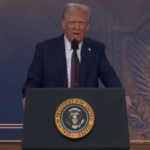U.S. Treasury yields have remained largely unchanged on Wednesday as investors exercise caution and await the Federal Reserve’s highly anticipated announcement on interest rates, scheduled for 2 p.m. Eastern Time (ET). Market participants are keenly analyzing economic data and comments from Federal Reserve officials for clues about the future direction of monetary policy amidst a complex economic landscape influenced by factors such as inflation and evolving trade dynamics.
As of late morning trading, the 10-year Treasury yield was hovering around 4.335%, a slight increase of just over one basis point. The 2-year Treasury yield also saw a marginal uptick, rising by over three basis points to 3.826%. These modest movements indicate a degree of stability in the bond market as investors largely hold their positions ahead of the central bank’s decision. Bond yields and prices move inversely, so a relatively stable yield suggests a balance between buying and selling pressure.
The Federal Reserve is widely expected to maintain the federal funds rate in its current target range of 4.25%–4.50% for the third consecutive meeting.According to the CME Group’s FedWatch Tool, market expectations overwhelmingly favor the central bank leaving borrowing costs unchanged, with probabilities exceeding 95%. This anticipation of no immediate rate hike reflects a cautious approach by policymakers as they assess the interplay of slowing inflation, a still-resilient labor market, and increasing uncertainty surrounding international trade.
Economic data released in recent weeks has presented a mixed picture, contributing to the Fed’s delicate balancing act. While some “soft” economic indicators have shown signs of weakening, “hard” data points, such as employment figures, continue to exhibit strength. Furthermore, the U.S. economy experienced a contraction in the first quarter of 2025, with GDP shrinking at an annualized rate of 0.3%. This downturn was largely attributed to a surge in imports as businesses and consumers accelerated purchases ahead of anticipated tariff increases proposed by President Donald Trump.
The potential inflationary impact of these “reciprocal” tariffs announced by the Trump administration on key trading partners remains a significant concern for investors and the Federal Reserve. Economists generally agree that tariffs are likely to exert upward pressure on prices, though the precise extent of this impact is still uncertain and will depend on the final tariff rates implemented and ongoing trade negotiations. A 90-day pause is reportedly in effect for many of the announced levies, adding another layer of complexity to the economic outlook.
Federal Reserve Chairman Jerome Powell’s post-announcement press conference will be closely scrutinized by market participants for any hints about the central bank’s future policy intentions. Investors will be particularly interested in his assessment of the current economic conditions, the Fed’s outlook on inflation in light of potential tariff impacts, and any signals regarding the timing of potential interest rate cuts later in the year. While market expectations currently lean towards a rate cut as early as July, some analysts suggest that the uncertainties surrounding trade and inflation could lead to a more prolonged “wait-and-see” approach from the Fed.
Treasury yields, which represent the return investors receive for holding U.S. government debt, are influenced by a multitude of factors including interest rate expectations, inflation, and the overall health of the economy. In times of economic uncertainty, investors often flock to the safety of Treasury bonds, which can drive yields down. Conversely, strong economic growth and rising inflation typically lead to higher Treasury yields as investors demand a greater return to compensate for the erosion of purchasing power. The current stability in yields suggests a market in a state of equilibrium, carefully weighing the potential implications of the Fed’s upcoming announcement and the broader economic landscape. Investors will be parsing the Fed’s statement and Chairman Powell’s comments for any indication of which way the balance might tip in the coming months.


















